
Economy to expand at healthy pace for years to come, report says
Growth of 7.75 percent in China's gross domestic product this year is possible, the International Monetary Fund said on Wednesday.
But the global organization said this hinges on decisive measures being taken to re-energize reform efforts in view of doubts posed by external and domestic downside risks.
It predicts the nation's economy will pick up moderately from the third quarter, as the lagged impact of strong growth in total social financing takes hold, in line with a projected mild recovery in the global economy.
Meanwhile, inflation will remain subdued this year, the organization's report said.
The IMF's economic growth expectation is higher than the government's target of 7.5 percent this year and also more optimistic than most global financial institutions' predictions, which range from 7.4 to 7.6 percent.
Last week, the IMF cut its forecast for China's economic growth this year to 7.8 percent from 8.1 percent and downgraded its GDP prediction for 2014 to 7.7 percent from 8.3 percent.
The National Bureau of Statistics reported lower-than-expected 7.5 percent growth in the second quarter, compared with 7.7 percent in the first three months, showing a deepening slowdown.
Premier Li Keqiang said on Tuesday that the policy stance should not change because of temporary fluctuations in the economic indicators.
Economists speculated that Li is signaling that the government is comfortable with the current pace of growth and will tolerate a moderate decline in the second half.
Zhang Zhiwei, chief China economist at Nomura Securities, said the authorities are prepared to take action and fine-tune policy if growth slows more sharply.
Zhu Haibin, chief China economist at JPMorgan, said tolerance of slower growth is not unlimited, as otherwise it will trigger financial risks in the economy and may cause a hard landing, disrupting social stability.
The IMF report said, "If growth were to slow too sharply below the authorities' target, on-budget fiscal stimulus should be used in a manner that supports rebalancing and helps protect vulnerable groups."
To unleash new sources of growth, China needs to stick to structural reform and leave more room for market forces, while preventing a financial crisis and moving toward a consumer-based, inclusive and sustainable growth path, the report said.
Overdependence on investment and fiscal spending, which was preferred after the global financial crisis, is unsustainable and the reform effort requires a revamp of local government finances, increasing State-owned enterprises' dividend payments to the budget and continuing tax reforms, it added.
"With a successful transition, China will grow at a healthy pace for years to come ... a growth trajectory that will also be good for the global economy," the report adds.
Paul De Grauwe, former economic adviser to the European Commission president, said, "The slowdown in China may also continue, as overcapacity
needs to be assimilated and economic restructuring is underway."
He agrees that a double-digit growth rate, mainly driven by investment and exports, is unsustainable.
"The world should get used to the slower pace of economic growth in China," he said, adding that a 5 to 7 percent rate annually is still acceptable.
Walter Vermeeren, president of Belgium-based NOVA Group, said China's growth, although less than expected, is still remarkable and Europe can only be jealous about it.
But he said China should continue to support development of its small and medium-sized enterprises, which provide most jobs.
China's key economic statistics in H1:
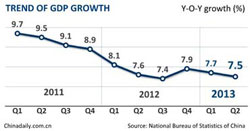
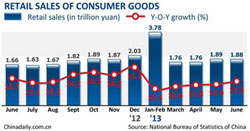
Q2
GDP growth slows to 7.5%
H1
retail sales accelerate to 12.7%

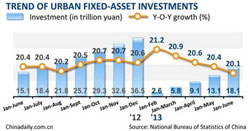
H1
industrial output up 9.3%
FAI
up 20.1% in H1

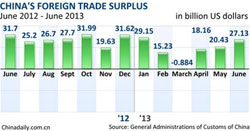
Fiscal revenue rises 7.5% in H1
Export down 3.1% in June


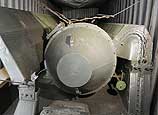













 China’s weekly story
China’s weekly story
(2013.7.5-7.12)


![]()
